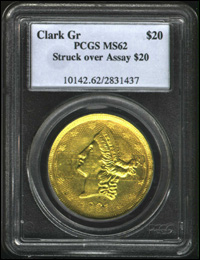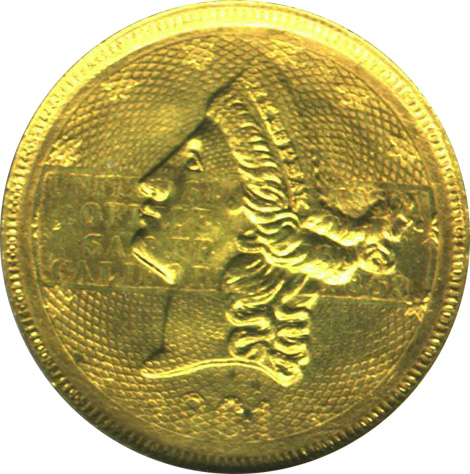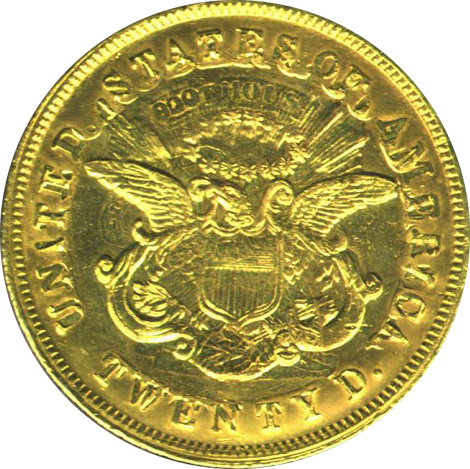
 Editor’s Note: The following description is from the Heritage Galleries 2002 September Long Beach Signature Sale Auction Listing.
Editor’s Note: The following description is from the Heritage Galleries 2002 September Long Beach Signature Sale Auction Listing.
1861 $20 Clark, Gruber & Co. Twenty Dollar (K-8) Struck Over an 1853 U.S. Assay Office Twenty Dollar (K-19) MS62 PCGS. New Kagin designation K-13d (see page 361 of pattern section). Brilliant prooflike surfaces with the center devices sharp and weakness around the edges.
This unique piece was unknown to us until a couple of years ago. We now know of five overstruck Clark Gruber & Co. Twenties. In the upcoming second edition of Private Gold Coins and Patterns of the United States, we plan to list all of these pieces in the pattern section and list them as Set-Up Pieces. This specimen will have the designation 13d. The other known pieces are:
13. Struck over an 1852 U.S. $20;
13a. Struck over an 1857-S U.S. $20;
13b. Struck over an 1849 U.S. $10;
13c. Struck over an 1850 U.S. $20.
Originally we believed that these specimens were overstruck in Philadelphia by the firm who designed the dies--the jewelers Bailey & Company. After further research and discussions with other numismatists, including John Dannreuther of the Professional Coin Grading Service, we now believe that these were struck in Colorado by Clark, Gruber & Co. to check the force of the striking and the spacing of the dies. This would account for the variance of the pressure and sharpness of the impressions. These Set-Up pieces are not unlike other similar types such as those seen for Morgan Dollars, Kennedy Half Dollars, and others. Before striking the regular gold blanks, which would have been considered quite precious even then, these test or trial strikings allowed the dies to first be properly aligned and avoid errors. They are recognizable because their central area is well to fully struck, while the periphery is weak or missing.
Evidently the coiners would take whatever gold coins they had on hand to test the new dies. On this specimen, the striking by the 1861 Clark dies on the obverse (tablet side) of the 1853 Assay Office $20 was not properly aligned causing parts of the host coin to appear as if were over the 1861 impression. While the central part of the Clark, Gruber Double Eagle is well struck (thus causing the flattened host Assay twenty), its periphery is not. This results in an odd looking phenomenon for the date and stars; the date has only a weak top half and the stars are only partially impressed. Similarly, the host Assay twenty details are rounded and not flattened there, as the Clark, Gruber dies did not fully impress those areas.
This also leads to the illusion that the Assay twenty is struck over the Clark, Gruber piece as the Assay detail is on “top” of the date and star detail of the Clark, Gruber since these areas were not flattened in the minting process. (These areas of the host Assay twenty would be just as flat as its central area and fields, if the date and stars area of the die had been fully struck with properly spaced dies.) There also are two obvious sets of denticles apparent from both impressions. This is a most unusual, interesting, and historic Gold Rush coin that represents true pioneer ingenuity in creating a medium of exchange in the underdeveloped West. Unique.
From The Estate of Jack L. Klausen. MS62 PCGS



